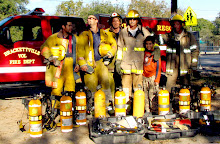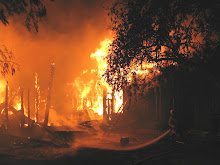Local and state fire resources remain on alert
Proactive attack saves lives and homes
COLLEGE STATION, Texas – When Texas Forest Service (TFS) and the National Weather Service began forecasting extreme fire weather danger earlier this week, TFS wasted no time activating preparedness measures and pre-positioning firefighting personnel and equipment to areas of the state predicted to be at highest risk. As it turns out, this preparation paid off.
The highest fire danger this year occurred on Monday (Feb. 25), and fire behavior was extreme. All available Texas Forest Service resources were committed to the fire fighting effort, including resources from east Texas and all available aircraft from the Texas Air National Guard. At the height of the fight, 1,000 gallon water drops from helitankers did little to slow advancing flame fronts. Tactics switched from offensive suppression efforts to the direct protection of homes and other assets on that day.
T. K. Kennedy, a helicopter manager in Abilene, summarized the day’s events, “We dropped 38,000 gallons of water today, mostly in people’s backyards.”
“Five communities were evacuated,” said James Hull, state forester and director of TFS. “Luckily, everyone was able to return to their homes that night.”
The severity of this year’s fire season is one of the worst seasons on record. Since January 2008, fires have consumed over 500,000 acres and destroyed 300 structures; however, an estimated 5,622 structures were saved.
Governor Perry has issued state disaster proclamations for 216 of the state’s 254 counties in response to the fire danger.
No significant relief is in sight. The long range forecast calls for a strong cold front to cross the state at the beginning of the week, with showers and thunderstorms likely for the eastern half of Texas and a chance of rain and snow in the Panhandle. Little or no rain is expected across far west Texas. Drier, cooler air will spread over all of the state by Tuesday, remaining in place through the end of the week. Fire risk will remain elevated west of Interstate 35 and critical in the Trans Pecos area. Therefore, local and state resources remain on alert.
“The local fire departments are our first line of defense,” said Mark Stanford, fire operations chief for Texas Forest Service. “They have reported to us that they responded to 3,060 fires so far this year for a total of 148,310 acres of the overall acres burned.”
Cooperating and assisting state agencies during the fire season include: Governor's Division of Emergency Management, Texas Department of Public Safety, TX Air National Guard, TX State Fire Marshall's Office and Texas Parks and Wildlife and Texas AgriLife Extension.
Out-of-state resources from Arkansas, Georgia, Kentucky, Louisiana, Montana and Virginia are providing relief and additional support. Assisting federal resources include the U.S. Forest Service, U.S. Fish and Wildlife Service, National Park Service and the Bureau of Land Management.
Citizens are urged to be extremely cautious during this period of critical fire danger. Some precautions suggested by Texas Forest Service include:
• Check with local authorities for Outdoor Burning Bans
• Your vehicle can start a fire if parked or driven in dry grass. ATVs and farming equipment can also start a fire if parked on the grass.
• Store flammable liquids properly.
• Remove dry vegetation from under electric fences.
• When welding, use a spotter, clear the area of dry vegetation, and have a water source handy. • Be sure tow chains are secure and don’t drag on the roadway.
• When grilling, place your barbeque over cement; be sure coals are dead out when you’re through (douse them thoroughly with water).
For more information on fire weather danger and advisories, go to http://tfsnews.tamu.edu/ and click on Wildfire Information.
Friday, February 29, 2008
Texas Forest Service News
Put out by
BVFD
at
2:31 PM
![]()
Labels: City of Brackettville, Texas Forst Service
Subscribe to:
Post Comments (Atom)













No comments:
Post a Comment